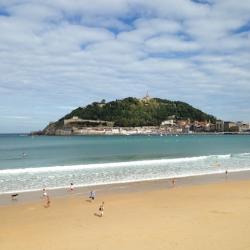 This year San Sebastian Gastronomika was host to the Italian cookery stallions. Nik Speller flew in to Food City to see of pasta could trump pinxos.
This year San Sebastian Gastronomika was host to the Italian cookery stallions. Nik Speller flew in to Food City to see of pasta could trump pinxos.
Life for everyone in San Sebastián is dominated by food, it would seem. As the taxi from Bilbao wound, stomach churningly, through the jagged hills of Northern Spain, the previously mute driver became increasingly animated as he described his cooking, his neighbours cooking, the cooking of chefs he had visited and that of chefs he had not.
Staggeringly, he’s a vegetarian or, at least, an aspiring vegetarian, struggling to piece together a decent meal from the meat-heavy Spanish menus. After an hour on the road, the hills split to reveal the sea, and I was soon left standing in the warm afternoon sun, watching as the driver sped away for his next fare, his disdain for the rich, heavy nature of modern cuisine still ringing in my ears.
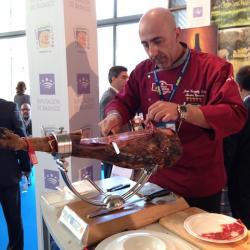 What a staggering introduction to San Sebastián, renowned by many as the culinary capital of Europe. A far better introduction than what was to follow that evening. The San Sebastián Gastronomika exhibition – a showcase of the great and good of Spanish, Basque, and this year Italian cuisine, and my reason for being in Spain – began with a cocktail-dinner in a soulless and deserted business park, a short twenty minute bus ride back through the hills. Punctuality isn’t a strong Spanish trait though.
What a staggering introduction to San Sebastián, renowned by many as the culinary capital of Europe. A far better introduction than what was to follow that evening. The San Sebastián Gastronomika exhibition – a showcase of the great and good of Spanish, Basque, and this year Italian cuisine, and my reason for being in Spain – began with a cocktail-dinner in a soulless and deserted business park, a short twenty minute bus ride back through the hills. Punctuality isn’t a strong Spanish trait though.
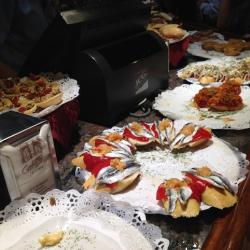 The bus was on time, the passengers all late. All, that is, except the foolish Englishman, who arrived first and spent an hour sat on a bus for a journey that took less than half that time. Hot, tired, thirsty, but free of the bus at least, the cocktail party was an equally hot cauldron, bubbling with chefs, foodies, journalists and olive oil merchants, eating quickly and drinking even faster. The food, as you’d expect, was excellent; the fact that it ran out after an hour, with a further two hours remaining, was not. Tempers seemed frayed and taxis were summoned to whisk a hungry and drunk crowd back to the bars in town.
The bus was on time, the passengers all late. All, that is, except the foolish Englishman, who arrived first and spent an hour sat on a bus for a journey that took less than half that time. Hot, tired, thirsty, but free of the bus at least, the cocktail party was an equally hot cauldron, bubbling with chefs, foodies, journalists and olive oil merchants, eating quickly and drinking even faster. The food, as you’d expect, was excellent; the fact that it ran out after an hour, with a further two hours remaining, was not. Tempers seemed frayed and taxis were summoned to whisk a hungry and drunk crowd back to the bars in town.
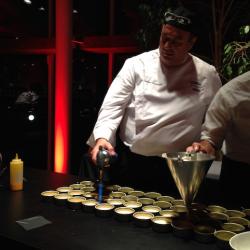 Of the dinner my elbows helped me to grab that night, the false egg and the millesime egg were the ones to remember. For the false egg, a thin crisp basket of something crunchy held an edible’egg’ shell, containing a creamy parmesan sauce and a soft oil-like’yolk’.
Of the dinner my elbows helped me to grab that night, the false egg and the millesime egg were the ones to remember. For the false egg, a thin crisp basket of something crunchy held an edible’egg’ shell, containing a creamy parmesan sauce and a soft oil-like’yolk’.
Any details given in English were lacking or not obvious to see; that said, the locals seemed to struggle with the concept of the egg shell anyway, leaving it to one side when it was perfectly edible and delicately sweet. The millesime egg was a spectacle to watch in it’s preparation, as well as it’s eating. Another creamy sauce, this time egg laden, but definitely containing cheese, was poured into a ramekin, flamed quickly with a blowtorch and covered in a more than generous shaving of white truffle. A slice of ciabatta was used to soak up much of the liquid and the rest finished with a tiny spoon. Of all the dishes, I didn’t see a single millesime egg left half-eaten in the exhibition hall – a firm favourite for all.
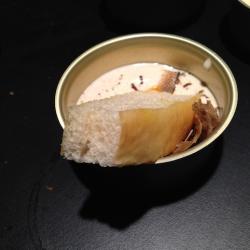 The next morning, mouth dry, head spinning and minibar void of its scandalously priced water, I set off for the first full day of the conference. It was sunny, yet cool beneath the tropical palms that lined the road outside the hotel. I’d been in the city almost a day, but hadn’t yet seen San Sebastián in the daylight. It’s spectacular, there’s not another word to describe it. From the hotel, a small uneven path weaved between the high walls of various sleepy residence, opening out high above the bay, where the city meets the sea.
The next morning, mouth dry, head spinning and minibar void of its scandalously priced water, I set off for the first full day of the conference. It was sunny, yet cool beneath the tropical palms that lined the road outside the hotel. I’d been in the city almost a day, but hadn’t yet seen San Sebastián in the daylight. It’s spectacular, there’s not another word to describe it. From the hotel, a small uneven path weaved between the high walls of various sleepy residence, opening out high above the bay, where the city meets the sea.
The bay is almost circular, with a small opening to the Atlantic, through which huge violent waves come crashing through against the rocks, the golden sands and the promenade, which circles the bay from point-to-point. The city is beautiful, with old and ancient buildings lining the pedestrianised streets along the water, immaculate public gardens and more benches than grains of sand on the beach. I missed the opening of the conference, delayed as I gawped (and photographed) in every direction along the thirty minute walk.
With so much beauty outside the walls of the conference, it was hard to concentrate on what was inside; especially as windows in the Kursaal Congress Centre number only two, closing out the view and the sunshine. Again, confusion reigned supreme. The registration desk is located through the first barrier, where they ask to see your registration card. A difficult circle to square. Inside the doors, almost immediately, attendees cluster together, shouting, screaming, hugging, kissing, flailing arms, spilling wine and stuffing faces with ham and cheese.
This was to be a dominant feature of the next two days – both the gaggle of attendees and the food. Say what you will about English cuisine, but we do variation well. Spain is a country of olive oil, ham and cheese; everything else is relegated to the plate of the vegetarian. I didn’t complain, at first – it’s delicious stuff – but, by day two a leg of pork or slice of manchego is not a welcome sight. And I wasn’t the only one. On the final day, as we entered the impressive hallway of the San Telmo Museum for nibbles, a veteran foodie from the US cried:’For God’s sake! Not more ham and cheese!’ I rest my case.
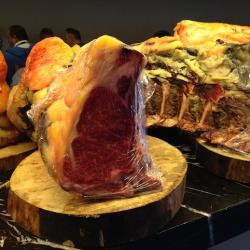 Aside from the confusion, the conference was interesting and intriguing. The discussions (when translated) were good, the cooking techniques, new and old, engaging. Chefs in every room were busy frying, skinning, boiling, malleting, peeling, chopping, roasting and even riding scooters on stage. The timetable took some deciphering – nothing written matched what I saw, in terms of content or timing. This was a ride on a river-rapid, where you jumped on, clung on, and looked at the scenery as it flashed past, rather that stop for a rest and a good look around.
Aside from the confusion, the conference was interesting and intriguing. The discussions (when translated) were good, the cooking techniques, new and old, engaging. Chefs in every room were busy frying, skinning, boiling, malleting, peeling, chopping, roasting and even riding scooters on stage. The timetable took some deciphering – nothing written matched what I saw, in terms of content or timing. This was a ride on a river-rapid, where you jumped on, clung on, and looked at the scenery as it flashed past, rather that stop for a rest and a good look around.
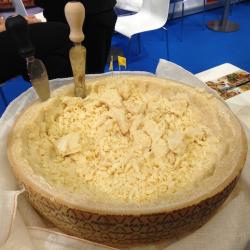 Talks were delivered at an alarming pace, in both Spanish and Italian; the theme this year being Italy – North vs. South. An army of some 20 Italian chefs, clutching 30 Michelin stars between them, had travelled to Spain. Massimo Botura, of Osteria Francescana in Modena, gave an opening speech, focusing on the value of local ingredients and the chefs role in saving traditional methods of production and cooking, being careful not to destroy them through development – he also doesn’t trust skinny chefs. This concept was visited a number of times – the power of tradition – but, there was also a strong leaning towards experimentation and the importance of taking risks to advance the’customer experience’ and avoid growing stale.
Talks were delivered at an alarming pace, in both Spanish and Italian; the theme this year being Italy – North vs. South. An army of some 20 Italian chefs, clutching 30 Michelin stars between them, had travelled to Spain. Massimo Botura, of Osteria Francescana in Modena, gave an opening speech, focusing on the value of local ingredients and the chefs role in saving traditional methods of production and cooking, being careful not to destroy them through development – he also doesn’t trust skinny chefs. This concept was visited a number of times – the power of tradition – but, there was also a strong leaning towards experimentation and the importance of taking risks to advance the’customer experience’ and avoid growing stale.
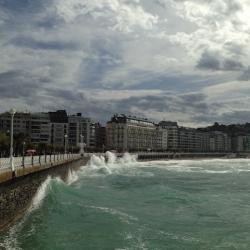 Nothing could epitomise the focus on simplicity more than grilling. One very moving talk to the largest auditorium focused on the late Pedro Arregui, a Basque chef and owner of Elkano – a restaurant further West along the coast from San Sebastián. Here, Pedro Arregui grilled most courses over a rustic BBQ; when asked what his father’s secret had been, his son told an interviewer at the conference, “buy good ingredients and try not to ruin them.â€Â
Nothing could epitomise the focus on simplicity more than grilling. One very moving talk to the largest auditorium focused on the late Pedro Arregui, a Basque chef and owner of Elkano – a restaurant further West along the coast from San Sebastián. Here, Pedro Arregui grilled most courses over a rustic BBQ; when asked what his father’s secret had been, his son told an interviewer at the conference, “buy good ingredients and try not to ruin them.â€Â
The idea of excellent cooking in small towns was a prominent feature of a number of talks by Italian chefs, who spoke of their continued discovery of great food cooked along the small pedestrianised streets of rarely visited Italian towns and villages. An idea later reiterated in a discussion around the power of travel and discovery, and it’s influence on’the’ chef, who absorbs experiences and translates them into cooking. Again, the often deep and philosophical debates were tempered by a humour that suggested good restaurants are simply a balance between simple ingredients, quality products, excellent service, and a good wine list.
By 8.00pm I was shattered and couldn’t face another bus ride into the bandit hills. Hastily downloaded Huffington Post’s’Top 9 Restaurants in San Sebastián‘ in my sweaty palm, I headed for the streets of the old town, which are lined with the many many many pintxos bars for which the city is famous. Here, the floor is paved with cobbles, English speaking tourists of every variety, and the spent napkins from the bar snacks on offer. In the bars, locals elbow foreign visitors clean out of the way, pushing to the bar, the beer, the wine and the plates of pintxos.
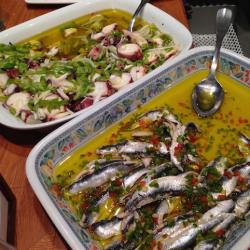 Bread is the staple here. Bread, with a pickled vegetable and a piece of meat and/or cheese – even the stack of mushrooms had a prawn balanced on the top. It is gorgeous food. So simple, so tasty and so cheap. Scant regard is given to the price list; instead, upon leaving, the barman just demands a suspiciously round (yet small) some of money. 10 Euro for the first plate, plus beer; 15 euro for the second, plus beer – that’s Eurozone inflation for you. But who cares when included in that price is a goat’s cheese, as big as your palm, balanced on a slice of bread, drizzled with a sweet balsamic reduction and covered with pistachios. Marvelous.
Bread is the staple here. Bread, with a pickled vegetable and a piece of meat and/or cheese – even the stack of mushrooms had a prawn balanced on the top. It is gorgeous food. So simple, so tasty and so cheap. Scant regard is given to the price list; instead, upon leaving, the barman just demands a suspiciously round (yet small) some of money. 10 Euro for the first plate, plus beer; 15 euro for the second, plus beer – that’s Eurozone inflation for you. But who cares when included in that price is a goat’s cheese, as big as your palm, balanced on a slice of bread, drizzled with a sweet balsamic reduction and covered with pistachios. Marvelous.
A lengthy stumble along the shore and I’m back in the leafy suburban hotel. Breakfast, more ham, more cheese and a bowl of coco-pops, is accompanied by Nespresso, the sales rep for which cleaned up in San Sebastián – you can’t get a different coffee anywhere. I expected better here, to be honest.
The second day is an English summer, rather than Spanish. Mild, windy, with threatening clouds blowing overheard. The sea became more threatening too, slamming against the promenade and sending plumes of salty-spray across the bay. The locals stand precisely where the waves are not, the tourists stand precisely where they are, dripping wet. Aside from the food, San Sebastián is a town for old people to shuffle along and sit – benches line every road – and young people to run, run and run some more.
I suppose it’s all the eating, but throughout the day and night, joggers pound the pavement. Feeling guilty, I joined them. Running between the points of the bay, warmed by the sun, cooled by the rain, it was a great way to see the town (although you could just walk); walkers on the sand, surfers in the waves and the pleasure boats bobbing the harbor. Like many cities, this beautiful façade is probably not representative, but it doesn’t matter – this is the view of San Sebastián I’ll remember forever.
The rabble of the conference came to a close (for me at least) with a dinner at the enchanting San Telmo Museum. A church-like building, that looks vacant from all sides but one, with candle-lit cloisters, art on every wall and a huge vaulted ceiling that the candles couldn’t reach. Here, we had a drink or two, more ham, more cheese and a loud blast of music in each ear. For a dinner, it was light on calories, so (unfortunately) it was back to the Pintxos bars for a late night snack. The bread, the meat, the mushrooms, the cheese, the tiny slivers of anchovy, all followed by a thick slice of bitter-sweet, crème brûlée-like cheesecake at La Viña. I’ve since read other people say it’s the world’s best. I’d have to agree – I really don’t see how that cheesecake could be bettered.
And then that was it. An early morning start for the flight back home. No time to give the sea one last wave, the bay one last glimpse, the pintxos one last nibble. I only scratched the surface in those two days and I know I missed a lot of the city, but the views, the food and the people were enough to leave me suitably impressed and leave me wanting more. That cheesecake alone has me itching to visit the Easyjet website to book another flight…
